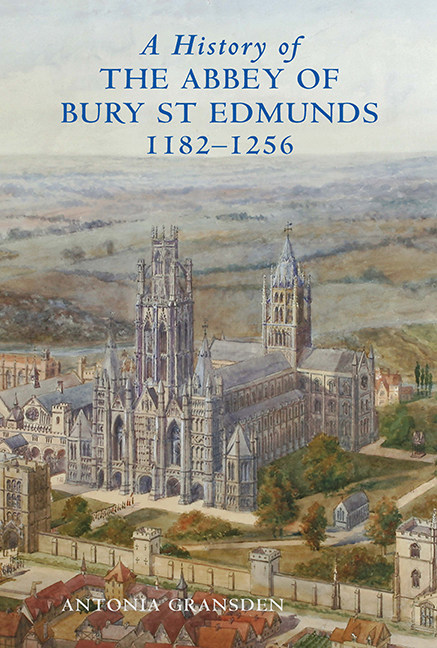Book contents
- Frontmatter
- Dedication
- Contents
- List of plates
- List of figures
- Preface
- Editorial Note
- Epigraph
- Acknowledgements
- Maps and plans (figures 1–9)
- Part I Samson of Tottington, Abbot 1182–1211
- PART II The Abbey 1212–1256
- 14 The vacancy, 1211–15, and election of Hugh of Northwold
- 15 The Abbots 1215–1256
- 16 Observance of the Rule of St Benedict
- 17 Learning
- 18 Books
- 19 Buildings
- 20 St Edmunds’ liberties and the Crown
- 21 Henry III and the cult of St Edmund
- APPENDICES
15 - The Abbots 1215–1256
from PART II - The Abbey 1212–1256
Published online by Cambridge University Press: 29 April 2017
- Frontmatter
- Dedication
- Contents
- List of plates
- List of figures
- Preface
- Editorial Note
- Epigraph
- Acknowledgements
- Maps and plans (figures 1–9)
- Part I Samson of Tottington, Abbot 1182–1211
- PART II The Abbey 1212–1256
- 14 The vacancy, 1211–15, and election of Hugh of Northwold
- 15 The Abbots 1215–1256
- 16 Observance of the Rule of St Benedict
- 17 Learning
- 18 Books
- 19 Buildings
- 20 St Edmunds’ liberties and the Crown
- 21 Henry III and the cult of St Edmund
- APPENDICES
Summary
Hugh of Northwold (Hugh II), 1215–1229
Hugh was a native of Northwold in Norfolk, which lay about six and a half miles from Thetford on the road to King's Lynn. It was under the jurisdiction and patronage of St Etheldreda's, that is, of Ely cathedral. People with the toponym ‘of Northwold’ first appear at St Edmunds’ in thirteenth-century records and in a list of c. 1300 a Sir Robert of Northwold appears among St Edmunds’ military tenants. Hugh's father, Peter of Northwold, and mother Emma appear in the Book of Benefactors: their respective anniversaries were celebrated with a toll of the bells (‘simplici sonitu’) and masses recited for their souls. On each occasion the monks received a pittance payable from the cellary. Hugh's family was not only of baronial status but it also included highly educated men, most notably Hugh's nephew, Nicholas of Ely, successively bishop of Worcester (1266–8) and Winchester (1268–80). Another nephew, William of Northwold, witnessed a charter during Hugh's abbacy. A William of Northwold, presumably not the same man, was a monk of St Edmunds, served as Abbot Simon of Luton's chaplain c. 1259/60, and was subsequently subcellarer, and then, jointly with ‘J’. of Mildenhall, cellarer.
Hugh of Northwold assumed the habit at St Edmunds in 1202 and at the time of his election to the abbacy held the office of subcellarer. Once abbot he remained so until his election in 1229 to the bishopric of Ely. Hugh soon proved himself an able and energetic abbot. His first concern was to establish his control and restore peace in the convent. The Electio ends with a general paean on his methods, emphasizing his firmness and just dealing and expressing the hope that Hugh will continue with such a wise policy. The author writes
the worthy Abbot Hugh, adorning his office by the divine will, manfully subdued the tempest of the mighty sea [Acts 27.18] raging against him, vigorously met and overcame the various slanders and deadly perils threatening him, and openly and completely trampled underfoot the perjury and false witnesses employed against him.
- Type
- Chapter
- Information
- A History of the Abbey of Bury St Edmunds, 1182–1256Samson of Tottington to Edmund of Walpole, pp. 165 - 195Publisher: Boydell & BrewerPrint publication year: 2007

